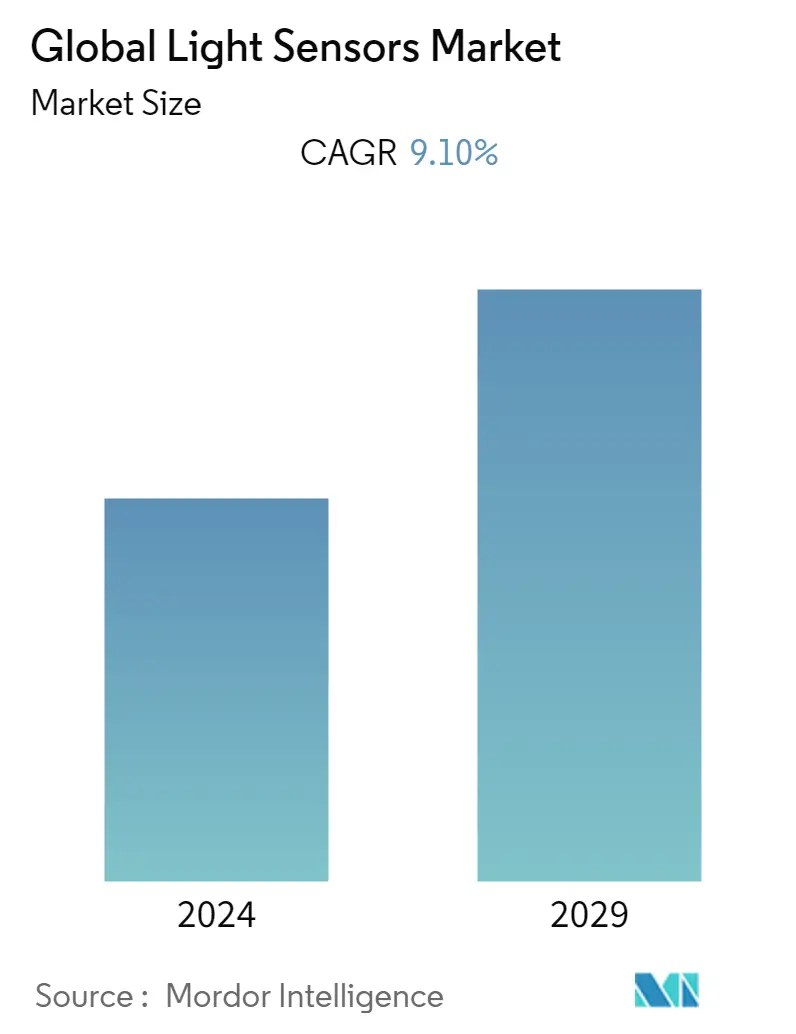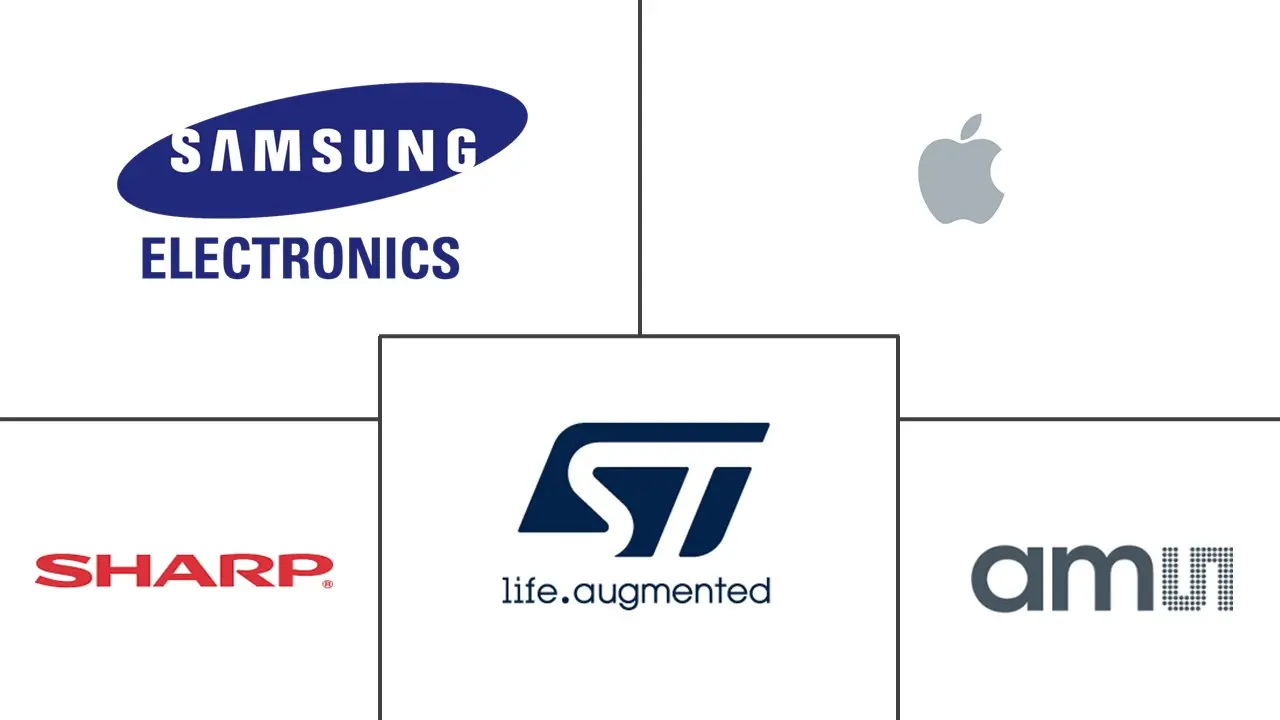Market Size of Global Light Sensors Industry

| Study Period | 2019 - 2029 |
| Base Year For Estimation | 2023 |
| CAGR | 9.10 % |
| Fastest Growing Market | Asia Pacific |
| Largest Market | North America |
| Market Concentration | Low |
Major Players
*Disclaimer: Major Players sorted in no particular order |
Light Sensors Market Analysis
The Global Light Sensors Market is expected to reach a CAGR of 9.1% over the forecast period. The factors driving the light sensors market include the growing implementation of light sensor functions in consumer electronics, such as smartphones and tablets. Also, advancements in the automotive sector, smart homes, and outdoor lighting are expected to boost the growth of the light sensors market. An increase in demand for sensors in the development of smart cities and a surge in IoT technology is also expected to fuel the growth of the light sensors market.
- For instance, proximity light sensors respond to changes in infrared light to detect motion or proximity to another object. They are used for devices in vehicles that sound an alarm when the vehicle is close to bumping into an object. Proximity light sensors are common in outdoor lights to detect motion for security purposes.
- Smartphone manufacturers are actively incorporating new technologies into their devices to improve their product quality in terms of product quality and vision. For instance, in April 2022, Oppo announced that its model, Oppo F21 Pro, will feature the flagship Sony IMX709 RGBW selfie sensor that is 60% more sensitive to light and reduces noise by 35% when compared to the previous generation IMX615 RGB sensor.
- In the automotive segment, with the development of new technologies such as lane assist, automatic headlights, and many more, these sensors are being integrated into rear-view mirrors, interior lighting, side-view mirrors, rain sensor, optical control knobs, and many more. Also, the increased adoption of LiDAR sensors in various industry verticals, such as aerospace and defense, corridor mapping and topographical survey, automotive, mining, and oil and gas, has also created growth opportunities for the light sensors market across industries.
- During the Covid-19 pandemic, the consumer electronics sector's growth rapidly changed, increasing competition among market players. Consumer electronics manufacturers are currently under enormous pressure to bring unique and differentiated products to market. Major smartphone manufacturers like Samsung collaborate with light sensor manufacturers to integrate both technologies. For instance, in November 2021, MacDermidAlpha Electronics Solutions announced a collaboration with STMicroelectronics, a global semiconductor leader helping customers across the spectrum of sensing applications, on a key sinter technology for Electric Vehicles inverter assemblies to increase vehicle efficiency and range while lowering production costs significantly.
- Due to the massive COVID-19 outbreak, people's priorities shifted to technology and health, increasing demand for ambient light sensors in applications such as medical devices. For instance, in October 2021, Osram developed an ambient light sensor for mobile devices and wearables that detects UV-A light. According to the company, while the UV-C portion of sunlight is blocked by the earth's atmosphere, UV-A and UV-B radiation reach the earth's surface. Sunburn is caused by UV-B radiation, which only penetrates the upper layers of the skin. This COVID-19 crisis is expected to provide opportunities for businesses to invest in, implement, and research technologies requiring a less human touch. For example, consider the combination of AI and automation.
Light Sensors Industry Segmentation
Light sensors detect and react to different levels of light in appliances, switches, and machines. Light sensors vary from those that respond to changes, collect current, or hold voltage depending on light levels. Light sensors are used for motion lights and robot intelligence, among other applications. These sensors are capable of detecting light that is not visible to the human eye, such as X-rays, infrared, and ultraviolet light.
The Global Light Sensors Market is Segmented by Type (Ambient Light Sensing, Proximity Detector, and RGB Color Sensing, Gesture Recognition, UV/Infrared Light (IR) Detection), Output (Analog and Digital), End-user Industry (Consumer Electronics, Automotive, Industrial), and Geography.
| Type | |
| Ambient Light Sensing | |
| Proximity Detector | |
| RGB Color Sensing | |
| Gesture Recognition | |
| UV/Infrared Light (IR) Detection |
| Output | |
| Analog | |
| Digital |
| End-user Industry | |
| Consumer Electronics | |
| Automotive | |
| Industrial | |
| Other End-user Industries |
| Geography | |
| North America | |
| Europe | |
| Asia-Pacific | |
| Latin America | |
| Middle-East and Africa |
Global Light Sensors Market Size Summary
The global light sensor market is poised for significant growth, driven by the increasing integration of light sensor technologies in consumer electronics, automotive advancements, and the rise of smart homes and outdoor lighting solutions. The demand for light sensors is further bolstered by the development of smart cities and the proliferation of IoT technologies. These sensors, such as proximity and ambient light sensors, are becoming integral in devices ranging from smartphones to vehicles, enhancing functionalities like motion detection and automatic brightness adjustment. The consumer electronics sector, particularly in regions like Asia-Pacific, is experiencing a surge in demand for these sensors, fueled by the miniaturization of devices and advancements in sensor technology. This growth is supported by collaborations between major manufacturers and sensor producers, aiming to incorporate cutting-edge technologies into their products.
The market landscape is characterized by a fragmented competitive environment, with numerous players striving to gain a foothold through strategic partnerships, product launches, and technological innovations. The COVID-19 pandemic has accelerated the adoption of light sensors, as there is a heightened focus on technology and health, leading to increased demand in applications such as medical devices. The automotive industry is also witnessing a rise in the use of light sensors for safety and convenience features. Despite the challenges posed by the additional costs and potential reduction in device lifespan due to sensor integration, the market is expected to continue its upward trajectory. The ongoing investments in smart city developments and the growing emphasis on security technologies in emerging economies are anticipated to further drive market expansion.
Global Light Sensors Market Size - Table of Contents
-
1. MARKET DYNAMICS
-
1.1 Market Overview
-
1.2 Industry Value Chain Analysis
-
1.3 Industry Attractiveness - Porter's Five Forces Analysis
-
1.3.1 Bargaining Power of Suppliers
-
1.3.2 Bargaining Power of Consumers
-
1.3.3 Threat of New Entrants
-
1.3.4 Threat of Substitutes
-
1.3.5 Intensity of Competitive Rivalry
-
-
1.4 Market Drivers
-
1.4.1 Advancements in the Automotive Sector Fuel the Market
-
1.4.2 Growing Implementation of Light Sensors in Smartphones and PC Tablets
-
-
1.5 Market Restraints
-
1.5.1 Low Light Sensing Capabilities Act as a Restraining Factor
-
1.5.2 Low-cost Sensors are Increasing the Threat to Scale Down the Quality
-
-
1.6 Assessment of the Impact of COVID-19 on the Industry
-
-
2. MARKET SEGMENTATION
-
2.1 Type
-
2.1.1 Ambient Light Sensing
-
2.1.2 Proximity Detector
-
2.1.3 RGB Color Sensing
-
2.1.4 Gesture Recognition
-
2.1.5 UV/Infrared Light (IR) Detection
-
-
2.2 Output
-
2.2.1 Analog
-
2.2.2 Digital
-
-
2.3 End-user Industry
-
2.3.1 Consumer Electronics
-
2.3.2 Automotive
-
2.3.3 Industrial
-
2.3.4 Other End-user Industries
-
-
2.4 Geography
-
2.4.1 North America
-
2.4.2 Europe
-
2.4.3 Asia-Pacific
-
2.4.4 Latin America
-
2.4.5 Middle-East and Africa
-
-
Global Light Sensors Market Size FAQs
What is the current Global Light Sensors Market size?
The Global Light Sensors Market is projected to register a CAGR of 9.10% during the forecast period (2024-2029)
Who are the key players in Global Light Sensors Market?
STMicroelectronics NV, AMS AG, Sharp Corporation, Apple Inc. and Samsung Electronics Co. Ltd are the major companies operating in the Global Light Sensors Market.

